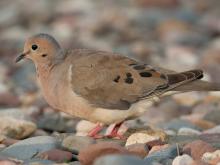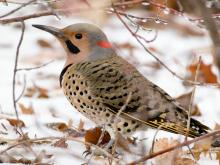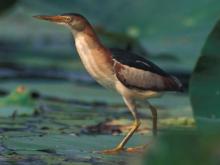Birds
Media

Species Types
Scientific Name
Quiscalus quiscula
Description
The common grackle makes “a mistake . . . in trying to sing,” a prominent birder once wrote of its kree-del-eeeeks and chlacks. Yet its iridescent purples, blues, and bronzes please the viewer despite the harshness of the voice.
Media

Species Types
Scientific Name
Podiceps auritus
Description
Horned grebes are small ducklike birds that may be seen in Missouri during migration and locally in the winter. Breeding coloration is different from that of winter.
Media

Species Types
Scientific Name
Sternula antillarum
Description
The least tern is gull-like, gray above and white below. The head has a black cap and nape, and a white forehead. The bill is bright yellow and its sharp tip is black. The tail is deeply forked. Look for it along big rivers April–September.
Media

Species Types
Scientific Name
Pluvialis dominica
Description
The American golden-plover is a robin-sized shorebird that makes an incredible annual odyssey from Argentina to the Arctic tundra, a distance of over 20,000 miles. It flies through Missouri in spring.
Media

Species Types
Scientific Name
Zenaida macroura
Description
Doves symbolize peace, and they are also a popular quarry of hunters. Our mourning doves are probably the closest living relatives of the extinct passenger pigeon. Learn more about these cooing seed-eaters!
Media

Species Types
Scientific Name
Columba livia
Description
This is the common pigeon of city parks, downtown buildings, barns, and cliffs. Many color forms exist. The wild type has a dark head, breast, and shoulders, a light gray body, two dark bars on the wings, a white rump, and a dark band on the tip of the tail.
Media

Species Types
Scientific Name
Colaptes auratus
Description
America’s flickers used to be considered three different species, but in the 1980s biologists determined otherwise. Now, our eastern “yellow-shafted” flicker, the “red-shafted” flicker of the west, and the “gilded flicker” of the southwest are all considered just forms of the same species: the northern flicker.
Media

Species Types
Scientific Name
Ixobrychus exilis
Description
One of the smallest herons in the world, the least bittern is about as big as a pigeon. It’s nearly impossible to locate when it hides in a cattail marsh. Most see it only in flight.
Media

Species Types
Scientific Name
Scolopax minor
Description
This remarkable bird is a short-necked, short-legged, terrestrial shorebird with a long bill. The eyes are set back on its head. When this bird is flushed, its short wings make a startling whirring sound.
Media

Species Types
Scientific Name
Quiscalus mexicanus
Description
The great-tailed grackle occurs mostly in western parts of Missouri, which is on the northeastern edge of its range. This blackbird’s long, V-shaped tail is distinctive, as is its song of whistles, clacks, chucks, and clicks.
See Also







Media

Species Types
Scientific Name
Hemaris diffinis
Description
The snowberry clearwing is a moth that confuses people because it looks like a bumblebee and flies like a hummingbird!
Media

Species Types
Scientific Name
Hyles lineata
Description
The white-lined sphinx moth sometimes confuses people because it flies, hovers, and eats from flowers like a hummingbird. The adults often fly during daylight hours as well as in the night and are often found at lights.
Media

Species Types
Scientific Name
Darapsa myron
Description
The Virginia creeper sphinx moth is common in woods and brushy areas and comes to lights at night. The larvae eat Virginia creeper and grape leaves.
Media

Species Types
Scientific Name
Perimyotis subflavus (formerly Pipistrellus subflavus)
Description
Tri-colored bats, formerly called eastern pipistrelles, are relatively small and look pale yellowish or pale reddish brown. The main hairs are dark gray at the base, broadly banded with yellowish brown, and tipped with dark brown.
Media

Species Types
Scientific Name
Myotis grisescens
Description
Gray myotises are difficult to distinguish from other mouse-eared bats. A key identifying feature of the gray myotis is that its wing is attached to the ankle and not at the base of the toes. It’s an endangered species.
Media

Species Types
Scientific Name
Myotis lucifugus
Description
The little brown myotis (little brown bat) is one of our most common bats, but populations are declining. White-nose syndrome has taken a heavy toll in northeastern states. This species is now listed as vulnerable across its range.
Media

Species Types
Scientific Name
Myotis sodalis
Description
The Indiana myotis, or Indiana bat, summers along streams and rivers in north Missouri, raising its young under the bark of certain trees. It is an endangered species.
About Birds in Missouri
About 350 species of birds are likely to be seen in Missouri, though nearly 400 have been recorded within our borders. Most people know a bird when they see one — it has feathers, wings, and a bill. Birds are warm-blooded, and most species can fly. Many migrate hundreds or thousands of miles. Birds lay hard-shelled eggs (often in a nest), and the parents care for the young. Many communicate with songs and calls.





















